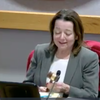Villages seek federal dollars for infrastructure projects
The villages of Altamont and Voorheesville have been included among 15 community development and improvement projects submitted by Congressman Paul Tonko to the House Committee on Appropriations “in an effort to bring federal investment to the Capital Region,” according to a release from Tonko’s office.
Altamont is seeking $1.2 million in funding for improvements to its wastewater treatment plant, while Voorheesville has asked for $300,000 to help pay for upgrades in the Salem Hills neighborhood.
Mayor Rich Straut said during the Voorheesville Board of Trustees’ April meeting that he and others from the village had a meeting with Tonko and “we explained that we are doing a lot of work on our infrastructure and that some of the traditional grants don’t apply to us,” by which he meant means-tested grants.
“Basically the median household income is usually a problem for us, to meet those requirements,” Straut said. Voorheesville’s annual median household income is approximately $103,000, about $28,000 over the national average.
Straut said the funding request is for infiltration and inflow work, mostly in the Salem Hills neighborhood, and that the village’s request is for $400,000.
The project description submitted to the Appropriations Committee said, “This project will help improve sewer infrastructure that has been identified as a leading community and regional weakness. Existing inflow and infiltration problems are compromising the capacity of the sewer system and preventing new development in Voorheesville and surrounding communities.
“Specifically, this project will fund final design, bidding, and construction of priority sewer collection upgrades and related engineering reports. This will include replacing approximately 3,600 linear feet of 60-year-old asbestos concrete pipes. New PVC pipes will be installed for wastewater collection systems at the treatment plant.”
Straut in April said, “We haven't really done any major repairs on the gravity sewers yet, which is mostly Salem Hills, [which] was built in the ’60s using old clay tile pipe. We’ve done a lot of TV [televised] and smoke testing. There’s a lot of problems identified. We have a report from the engineers that shows holes in the pipe, offset joints, [and] a lot of places where water can come in and leak.”
Straut concluded, “Basically what we’ve asked for is money to help mitigate that effects.”
Altamont
About two-thirds of Altamont’s wastewater treatment facility on Gun Club Road is a decade old; the remaining third is over 40 years old.
The village uses chlorine on the effluent, or sewage discharge, that leaves its wastewater treatment facility. Prior to the now-decade-old upgrades, the effluent flow was constant, but now the release is in batches throughout the day.
This makes it difficult for workers to correctly regulate the sodium bisulfite needed to remove the chlorine, so the batch is over-injected, which caused the state to step in about three years ago.
The state recommended the village switch to an ultraviolet system and remove the sodium bisulfite and chlorine entirely because, for the chlorine to interact with the effluent in the plant, the effluent has to be held in the plant for a set amount of time for the chlorine to act.
The old “clarifier,” from the 1930s, which was converted to a contact tank to hold water, is now rotten and falling in on itself. A clarifier is a large tank where all the sewage is broken down by bugs that in turn create sludge; the sludge then is hauled away either to Albany or Schenectady.
Following Altamont’s upgrades, new clarifier tanks were built and the old clarifier tank from the 1930s was converted to a “contact” tank. In the new system, effluent goes through the filters and chlorine is injected to kill any bacteria. But the chlorine needs time to kill the bacteria, so the effluent sits in the contact tank until the chlorine reacts with the bacteria in the water.
“So, we’re going to have to look at either major repair or replacement on that, and then we’re still back in the same boat with the chemicals,” former Altamont Superintendent of Public Works Jeff Moller told The Enterprise in March 2021. “Where a UV system would alleviate both problems.”
With the current treatment system, chlorine is injected into the water to kill E. coli and other bacteria. With the UV system, ultraviolet light tubes are inside a unit that the water passes through and the UV light kills the bacteria.
So light, not chemicals, is killing the bacteria.
In the long-run, a UV system would be less expensive, but the “upfront cost is quite expensive,” Moller said at the time.
Altamont’s project description submitted to Congress said its “wastewater treatment plant (WWTP) currently uses a chlorination/dechlorination chemical disinfection system. The effluent flow meter is no longer working and the chemicals have to be manually adjusted, which can cause the WWTP to be non-compliant with its [State Pollutant Discharge Elimination System] permit requirements.
“The proposed projects will include the installation of an ultraviolet disinfection system. The proposed system will include automated controls, decreasing the need for operator attention and ensuring continued compliance with the facility’s [State Pollutant Discharge Elimination System] permit requirements.
“Proper operation of the facility’s disinfection system will protect the health and safety of Village residents, and protect the water quality of the Bozen Kill, which is the receiving water for WWTP effluent. The Bozen Kill flows into the Watervliet Reservoir, making its protection a critical regional interest as it is a water source for thousands of local residents.”



